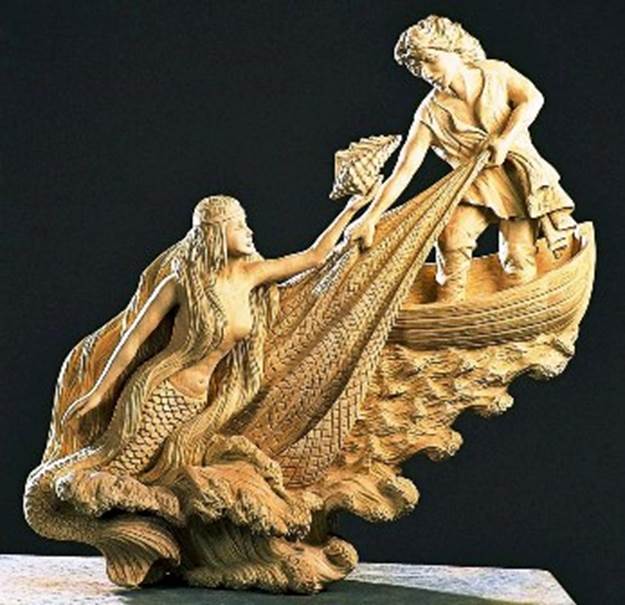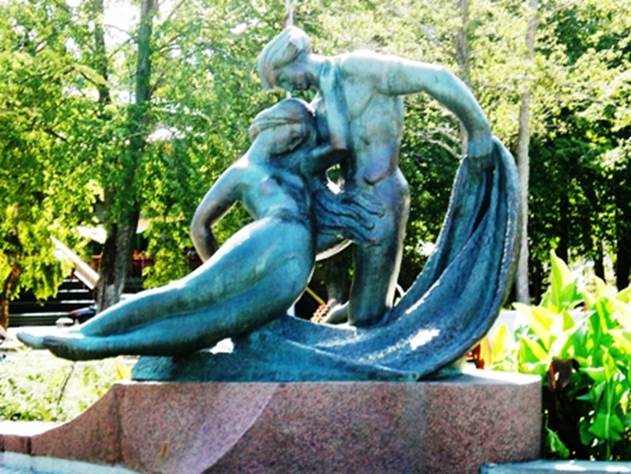Oh, listen on the evenings,
When lagoon waves are uneasy
And sprinkle the shore with amber
The unseen handful of depth
Maironis

Oh, listen on the evenings,
When lagoon waves are uneasy
And sprinkle the shore with amber
The unseen handful of depth
Maironis
Nations that knew of amber for many ages wondered what this beautiful gift of nature is and how it originated. Until science explained the truth about amber, nations created various legends and myths basing them to on their living conditions and customs. Some of them reached our times. In those myths the origin of amber was attributed to godly nature as many other natural phenomena that they didn‘t understand.
A renowned Roman poet Ovidius rhymed a myth about Phaeton at the beginning of our era and this myths tragic final the origin of amber is explained. According to Ovidius, amber is the tears poured out by the Sun god‘s Febus wife Klimena and her daughters when mourning Phaeton’s fate. God wanted to ride his father‘s Febus carriage of the Sun, but didn‘t know how to control the horses, got too close to the ground and torched it. For this Zeus plunked him to the River of Eridan.
Phaeton’s mother Klimena and his sisters were very sorry for him and wept uncontrollably. They grew into the earth while weeping and turned into trees. Out of those trees sap tears also dripped. They dry out because of the Sun and turned into amber are caught by the river and is sent to the Roman women so they could adorn themselves.

Legends about amber were also created in Lithuania. They were born out of beautiful views of the Lithuanian coast and those circumstances how amber got into the hands of people living here. Amber is thrown to the golden Lithuanian coast by the uneasy and deep-breathing Sea. And the more deep and stormy is the breathing, the more amber drops or sometimes big lumps are spread onto the Baltic coast.
This poetic amber‘s travel from the depth onto the shore gave birth to a fantastic legend by the people that didn‘t know the history of amber. According to the legend, every piece of amber washed out by the sea is the fruit of incredibly noble, passionate and tragic love story. That‘s why it‘s clear as a teardrop, pure as the love of Jūratė and Kastytis.
This happened long long time ago, when God Perkūnas was the highest God among all Gods and goddess Jūratė lived in amber palace at the bottom of the sea. She was the most beautiful of all goddesses and didn‘t know what is human love.
At Sea, near the mouth of the River Šventoji, a brave fisherman Kastytis was catching fish of Jūratė‘s underwater kingdom with his fishing net. Jūratė sent mermaids to warn Kastytis not to trouble the Baltic waters and scare the fishes. But the fisherman wasn‘t afraid of the goddess‘s warnings, disregarded the seductions of the mermaids and kept on throwing his nets into the Baltic. Jūratė fell deeply in love with Kastytis because of his braveness and handsome looks and lured him into the amber palace.
Perkūnas was highly wrathful when he learned that an immortal goddess fell in love with a son of a fisherman. With his lightning he destroyed the amber palace, killed Kastytis and chained Jūratė to the ruins of the palace walls.
Here Jūratė constantly weeps for Kastytis and their unhappy love and is tossed by the waves of the sea. Her wailing is so moving that the ever-cold and calm sea depths start to worry, reel and storm, thus washing the remains of the amber palace destroyed by Perkūnas onto the shore.
The tiny amber pieces are Jūratė‘s tears, so pure and clear as was pure and chaste her tragic love.

In this way is the origin of amber is explained in this Lithuanian legend created many ages ago. Lithuanian poets, composers, painters inspired by it created marvelous creations: Lithuanian poetry classic Maironis wrote a lyric poem „Jūratė and Kastytis“ and the composer J. Gruodis wrote a ballet according to its story. V. Klova wrote a symphonic poem, K. Kaveckas – a choric poem, painter S. Kazimieraitis created a colorful stained glass on this theme, sculptor N. Gaigalaitė created a beautiful sculptural composition that imagines Jūratė and Kastytis (this bronze creation now stands in Palanga in the fountain at the end of Basanavičius street close to the sea dunes).